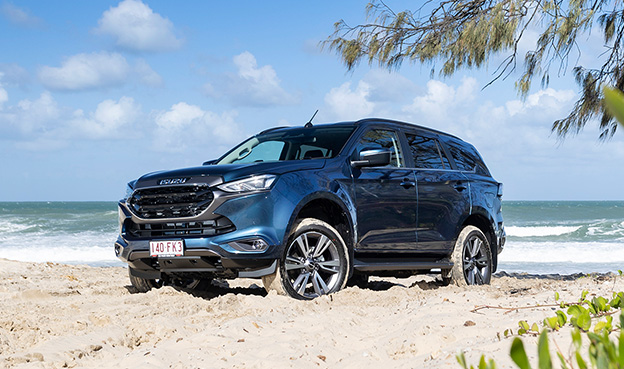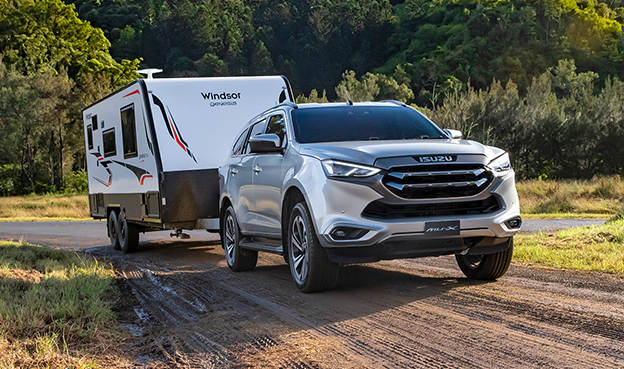

With fuel prices up, efficiency and operating costs are crucial to businesses and families alike. Isuzu has a 1.9-litre turbo-diesel solution. You might call it ‘the little engine that could’. Arriving in 2022, the D-MAX SX Single Cab Chassis 4x2 boasted an intriguing 1.9-litre heart. Isuzu’s frugal RZ4E-TC turbo-diesel engine quickly earned its stripes as a fuel-efficient and robust powerplant—one that arrived at the right time, just as diesel found itself on the wrong side of the $2.00-per-litre mark. With those runs on the board, Isuzu has now made the pint-sized oiler available across a wider range of models.
ALL TORQUE, ALL BITE
Good things often come in small packages and, with an 80mm x 94.4mm bore and stroke, the 1,898cc RZ4E-TC punches well above its weight. It generates a respectable 110kW of power at 3600pm and 350Nm of torque from 1800–2600rpm—but as ever, the real story is the width of the torque band.
The maximum torque output is delivered across a quarter (26.6 percent) of the rev-range, with 300Nm spanning 71.6 percent of the same rev-range, between 1550rpm and 3700rpm. That wide band across the 2150rpm mid-range results in near-instant torque on demand, with associated benefits in driveability and performance, particularly when carrying a decent payload or towing.

BUILT TO LAST
Evolving from Isuzu’s proven 4J-series 3.0-litre turbo-diesel engine, the RZ4E-TC is the 4JJ3-TCX’s little brother in every sense of the word. Engineered with commercial operators in mind, the 1.9-litre features a relatively low 15.9:1 compression ratio for engine lifespan longevity and utilises a cast-iron upper-block for strength and aluminium lower-block (crankcase) for lower mass.
Just like the durable 4J, each cylinder bore is treated and strengthened with Isuzu’s induction-hardened melt-in liner. That significantly improves strength and lowers friction for longevity and efficiency, without the need for an additional heavy steel bore liner. Each lightweight aluminium piston features a tapered internal combustion chamber for efficient air-and-fuel combustion and internal cooling passages for heat dissipation, longevity, and lubricity. Each piston skirt is treated with a low-friction coating for improved durability, lower friction, and thermal management.
An offset gudgeon pin keeps the connecting rod at the optimal angle during the power stroke—increasing internal efficiency, while reducing friction, wear, noise, and power loss. The carbon steel crankshaft is soft-nitriding treated for durability and strength, while each connecting rod and crankshaft bearing is constructed with a special, patented aluminium alloy for longevity.
The cylinder head is constructed using Isuzu’s patented aluminium alloy for the optimal blend of durability and lightness, while the valvetrain features double overhead camshafts, with each cam lobe also induction hardened. Roller-bearing rocker arms actuating the 16-valves feature an automatic hydraulic lash adjuster, which maintains optimal valve clearance at all times, meaning less maintenance and lower cost of ownership. A robust, maintenance-free steel timing chain keeps the pistons, crankshaft, and valve-train in time, which also reduces servicing costs.

To generate power and torque, an engine requires efficient combustion of air and fuel. Fuel delivery is precisely controlled by a DENSO high-pressure direct injection fuel system. It’s the same hardware used by the 4JJ3-TCX and pressurises diesel fuel to over 250MPa before it is atomised precisely into the combustion chambers atop each piston by the Gen-4 8-hole direct injectors.
The RZ4E-TC breathes through a new forward-facing air intake system that feeds the electronically controlled Variable Geometry System (VGS) Turbocharger. That system features constantly variable exhaust vanes within the exhaust turbine housing to control boost pressure, maximise efficiency and reduce turbo-lag. The pressurised intake air is then passed through a high-mounted aluminium air-to-air intercooler, which cools the charged intake air for maximum efficiency before entering the combustion chamber.
The high-mounted position of the intercooler not only minimises the intake tract for improved engine response, but it also keeps the aluminium core away from potential debris-strikes while off-roading. Mounted on the back of the VGS Turbocharger is Isuzu’s tried and proven Diesel Particulate Diffuser (DPD), a maintenance-free design that utilises high exhaust temperatures for efficient operation that aids in longevity.
GO FURTHER FOR LESS
As innovative as the hardware is under the bonnet, the end result is efficiency and durability. Going longer without the need for stopping at a bowser has its merits, both in time saved and to the hip pocket. And with an official combined-cycle fuel consumption return of 6.7 to 7.0-litres/100km, these RZ4E-powered utes boast the ability to travel upwards of 1000 kilometers on a single tank of diesel.
So, is the RZ4E-TC the little engine that could? Perhaps. But while that title does have a certain ring to it, Isuzu’s 1.9-litre wonder feels a bit more willing—and definitely more decisive. You might call it ‘the little engine that could’. But you’d be closer in saying that, day-to-day, year-to-year, the RZ4E-TC is the little engine that does.





